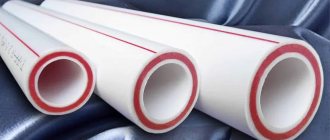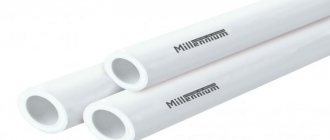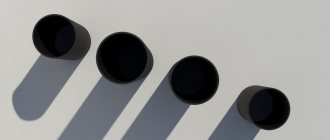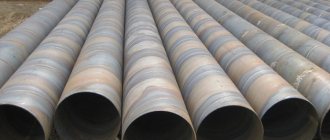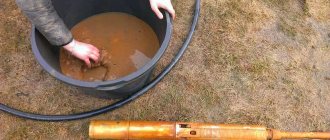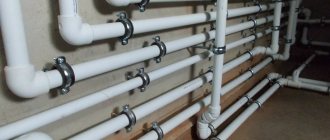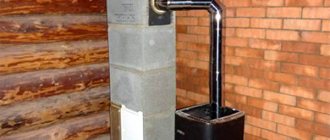Behind the designation “plastic pipes” lies a huge range of pipe products made from various types of plastics and with different characteristics and sizes. Choosing the appropriate option for a plumbing system in a cottage or apartment is often incredibly difficult. Some of them are intended only for cold water, while others can also be used for hot water supply and heating. To make the right choice, you should carefully study all the parameters of PVC, PEX, PP and HDPE pipes for water supply. Otherwise, you will inevitably have to spend money on repairs due to the resulting flood.
The popularity of plastic pipes for water supply
The popularity of plastic water pipes is due to their low cost, resistance to corrosion and long service life. This is an ideal material for organizing your own water supply in your home. Steel analogues are more durable, but over time they rust and are difficult to install independently.
Application of plastic pipes
To understand which pipes for water supply are better, it is necessary to analyze all their parameters. The service life of all manufacturers of such plastic products is stated to be 50 years. However, the temperature and pressure of the water that will then flow through the assembled pipeline are extremely important here. If you take a pipe with properties that do not correspond to reality, then it will last much less than the half-century indicated in the technical data sheet.
Advantages of PVC pipes
Another important point is cost. In the store, you should look not only at the price of a plastic pipe, but also immediately estimate the costs of installing a water supply system from it. In some cases, you can get by with press fittings and wrenches, while in others you will have to get a soldering iron for plastic somewhere.
No. 2. Stainless steel pipes
To obtain a corrosion-resistant material, steel is alloyed mainly with chromium. “Stainless steel” looks great and has outstanding performance qualities. It is as durable as pipes made of ordinary and galvanized steel, withstands changes in pressure and temperature, and is not afraid of shocks. Moreover, such pipes are not afraid of corrosion , so the upper limit of durability exceeds 50 years. Among the main disadvantages is not even the complexity of installation, but the high cost of the material, which is why stainless steel pipes are used extremely rarely today, although they are excellent for hot and cold water supply systems.
PVC
Pipes made of polyvinyl chloride (PVC, PVC), among other plastic analogues, are characterized by high tensile strength and a low coefficient of linear expansion. These products have a relatively low operating temperature (only up to +450C), so they are recommended for use only for cold water. However, due to additives, PVC is less flammable than polyethylene and polypropylene.
Among the advantages of plastic pipes for PVC water supply are:
- high impact strength;
- good frost resistance (can easily tolerate freezing down to -100C);
- resistance to acids and chlorine compounds;
- no tendency to crack after several years of use.
PVC is non-toxic, the water in pipes made from it is not colored and does not receive an extraneous chemical taste. The permissible pressure in a polyvinyl chloride water supply system, depending on the internal diameter and wall thickness, ranges from 6 to 16 atm.
Composition of polypropylene pipes
The main disadvantage of this type of pipe is poor tolerance to ultraviolet radiation and complete intolerance to high operating temperatures. If water heated to +700C is run through a water supply pipeline assembled from them, the PVC will begin to lose its plasticity and gradually deteriorate. For cold water supply and sewerage this is the best option, but for heating and hot water supply it is worth choosing something else.
Main characteristics
Unlike steel profiles, plastic materials do not corrode, do not increase internal resistance, and the loss of fluid pressure due to friction is 30% lower than that of analogues. The pipes are frost-resistant and retain their flexibility when the temperature decreases.
Products made from polymers have low weight, high throughput and low thermal conductivity.
Diameters of plastic pipes for water supply and other overall dimensions
The stress that arises inside the pipe when pumping liquid is directly proportional to the hydrostatic head and the reduced average diameter of the profile and inversely proportional to the thickness of its wall. Therefore, when choosing polymer pipes, you need to take into account that by increasing or decreasing the size of the products, you can exceed the design hydrostatic pressure.
Dimensions of plastic pipes for water supply, table:
| Outside diameter | Wall thickness, mm | ||||
| Polyvinyl chloride | Polypropylene | Metal-plastic | HDPE | Cross-linked polyethylene | |
| 10 | 1,38 | 1,80 | 1,35 | — | 1,28 |
| 12 | 1,38 | 2,00 | 1,65 | — | 1,40 |
| 16 | 1,79 | 2,70 | 2,18 | 3,00 | 1,80 |
| 20 | 2,28 | 3,40 | 2,76 | 3,38 | 2,27 |
| 25 | 2,65 | 4,16 | 3,46 | 4,17 | 2,80 |
| 32 | 3,56 | 5,38 | 4,36 | 5,37 | 3,58 |
| 40 | 4,50 | 6,65 | 5,50 | 6,67 | 4,50 |
| 50 | 5,58 | 8,30 | 6,87 | 8,30 | 5,57 |
| 63 | 7,10 | 10,50 | 8,60 | 10,50 | 7,10 |
| 75 | 8,40 | 12,50 | 10,30 | 12,50 | 8,40 |
| 90 | 10,10 | 15,00 | 12,30 | 15,00 | 10,10 |
| 110 | 12,30 | 18,30 | 15,10 | 18,30 | 12,30 |
Weight
The calculated mass of pipes, structures and connecting elements must correspond to those specified in the regulatory documents. The weight of plastic materials simplifies the assembly of networks and reduces the load on the brackets to which the lines are attached.
Over time, the load-bearing and strength characteristics of the walls decrease. This fact is not always taken into account by installers when choosing fasteners. Incorrect application of the calculated weight of 1 m of pipeline can lead to unpredictable consequences.
Knowledge of the weight standard characteristics of products will allow you to create durable and reliable communications.
Diameters of water pipes.
Strength
The durability of pipes depends on the material used, which is characterized by permissible long-term strength, wall thickness and pipe diameter. Based on these values, the primary stress of the profile wall is calculated, which sets the stability margin. The loss of structural strength depends on temperature, pressure and operating time.
Strength tests of individual samples are carried out in laboratory conditions at a temperature of 20°C, artificially subjecting them to deformation - aging.
The longer the aging time, the higher the durability of the pipeline.
Temperature
Composites have different ranges of maximum operating temperatures, within which the product retains its physical and mechanical characteristics. Changing the permissible application parameters increases the effect of linear elongation, while the pipeline loses its rigidity, the line sags and depressurization of connections may occur.
To avoid such situations, you must strictly adhere to the recommended temperature conditions and, when installing water pipelines, comply with the design standards for the distances between the main supports.
Types of water pipes.
Polypropylene
Polypropylene pipes for water supply have the highest operating temperature among plastic analogues (up to +700C). However, this plastic does not tolerate frost well and can crack when cooled below zero. In a house or apartment, a pipeline made from it will last for many years, but this option is not suitable for installation on the street.
Application of polypropylene pipes
When comparing pipes made of HDPE, PVC and polypropylene by price with the same internal diameter and equal length, the latter turns out to be the most expensive among them. But it has better almost all characteristics. Plus, fittings for polypropylene products are several times cheaper than those designed for polyvinyl chloride or polyethylene pipes. As a result, the final cost of plumbing in most cases is cheaper.
Black pipe from the manufacturer – import substitution in action.
It is much more profitable to buy all goods directly from the manufacturer, since intermediaries inflate prices and have a worse understanding of the characteristics of the product. The production of PE pipes near Moscow minimizes the cost of delivery throughout Moscow and the Moscow region.
Pipes from Western manufacturers are of good quality, but they scare the domestic buyer a little with their exorbitant prices. PE pipes made in China are very cheap, but they fail too quickly. In such a situation, it’s time to pay attention to the products of a domestic manufacturer, which maintains high quality but does not inflate the price. This is real import substitution in action.
We produce black smooth polyethylene pipes in compliance with all standards and, if the customer wishes, we can provide a full package of documentation. High quality products are guaranteed by our specialists and proven technology. Another important advantage of working directly with the manufacturer is the ability to order pipes of non-standard thickness and diameter. If you pay additionally (or order a large volume), we produce pipes according to any customer specifications.
Before purchasing a pipe, you can get competent advice from our specialists on any issue (this point is always much more difficult for intermediaries to carry out, because they are simply not aware of all the details). Black polyethylene pipes are sold from the warehouse. Delivery is carried out in Moscow on the day of order (if in stock), and to other cities of Russia from one day.
We always take into account the buyer's situation and try to organize delivery in the form most convenient for the client. Both wholesale and retail sales are possible. Each client receives individual work and consultation on all issues of interest. Call us, we are ready for fruitful cooperation!
Polyethylene pipes (HDPE)
Polyethylene pipes (HDPE) can easily withstand temperatures from -40 to +400C. This is the best choice when it is necessary to lay outdoor water pipes in the ground. However, under the rays of the sun, this plastic begins to age, becoming brittle. It cannot be left without UV protection. HDPE pipes can withstand pressure up to 10 atm. This is more than enough for cold water and hot water supply in the house.
Design and installation of polyethylene pipes
Among the main advantages of polyethylene pipes it is worth noting:
- a large assortment of adapters for steel and copper and other connecting parts for a variety of sizes;
- flexibility (these pipes are usually supplied in coils);
- availability of three connection options (welding, electric couplings and compression fittings).
The main disadvantage of HDPE pipes is the sagging of the pipeline when heated. This plastic has the highest linear expansion coefficient. It easily tolerates a short-term supply of water heated to +700C. But then the sagging HDPE water pipe does not look very aesthetically pleasing. This point must be foreseen in advance when designing the water supply, so that polyethylene pipes can expand without interference and are not visible behind the finish.
Errors in connecting polyethylene pipes
This type of pipe products also includes PEX pipes made of cross-linked polyethylene. They consist of several layers of plastic “cross-linked” at the molecular level. This option is superior to conventional HDPE polyethylene pipe in strength and operating temperature (up to +900C). But it also costs more. Moreover, in terms of the range of produced sizes and lengths, they are identical.
Advantages and disadvantages
Traditionally used for water supply systems, steel pipes have begun to cause many complaints regarding the corrosion resistance and durability of structures.
These facts explain the undeniable advantages of polymer products for a number of properties:
- Durability (25-50 years).
- High resistance to chemical attack.
- Smooth inner surface.
- No deposits on the walls that affect the purity of the transported drinking water.
- Resistance to corrosive processes.
- Light weight and easy to install structures.
- Thermal insulation properties.
- Heat resistance.
- Low price.
- Minimum operating costs.
- Does not require painting or waterproofing.
- Good soundproofing qualities
Flaws:
- the strength of steel pipes is higher than that of plastic fittings;
- when laying external networks in an open way, direct exposure to ultraviolet radiation reduces the service life of products;
- unreinforced polymer profile has a high linear elongation coefficient;
- diffusion of oxygen into transported liquids is possible.
Metal-plastic
The metal-plastic version (PEX-Al-PEX) is a layer cake made of inner and outer layers of polyethylene, between which aluminum foil is sandwiched. These products are more intended for heating systems. But it is quite possible to make a water supply system from such a pipe. It will just be quite expensive.
The main disadvantage of metal-plastic lies in its multilayer structure. Due to the presence of an aluminum layer, such a pipe is more difficult to solder. Plus, over time, these layers can separate from each other.
Regulatory technical documents
The design, production and use of polymer products must be carried out in accordance with regulatory documents. In Russia this is GOST R 52134-2003.
The technical conditions apply to pressure water pipes and connecting elements made of synthetic materials. They regulate technical parameters that affect the service life of products. The standard defines the duration of hydrostatic strength of materials, operating conditions measured by a set of temperatures and the time of their influence, as well as pressure parameters.
Features of installation and connection of plastic pipes
Plastic pipes for water supply are connected:
- PVC – gluing with special glue;
- PP – soldering with a soldering apparatus;
- HDPE and PEX – electrofusion welding and compression fittings;
- PEX-Al-PEX – press fittings and compression fittings.
Installation of plastic pipes
The most difficult thing to install is metal-plastic. Here you need to make sure that the aluminum layer does not wrap inside the pipe and is not over-tightened when cutting it. At first glance, gluing and soldering are easier. However, in this case, it is extremely important to correctly set the temperature of the soldering iron according to the corresponding tables from the manufacturers, depending on the thickness of the pipe walls. Plus, the device itself needs to be rented somewhere else; buying it for a one-time job will be expensive.
Welding time for plastic pipes during installation of water supply and sewerage systems
Soldered or glued plastic pipes form a non-separable pipeline. It is more difficult to repair, but it is more reliable. Fittings (especially wrench-type ones) are easier to work with. But they will then have to be regularly inspected for leaks and tightened.
Connecting plastic pipes using fittings
Metal-plastic
Metal-plastic pipes for water supply.
Metal-plastic has a complex structure and consists of 5 layers. This is polyethylene on the outside and inside, connecting 2 joints with adhesive, aluminum.
Metal-plastic is of high quality, so it is used for arranging heated floors and other closed-type works.
The pipe must be laid without installing joints.
Joint connection options:
- fitting;
- compression connection.
When exposed to high temperatures, the aluminum layer does not change its integrity and does not expand.
Abbreviation
When purchasing, you need to pay attention to the labeling from the manufacturers.
Below are the notations:
- maximum permissible pressure (for example, 10 bar);
- upper limit of permissible coolant temperature: +95°C;
- pipe diameter: 16 mm.
If the marking contains the designation “X”, then all seams are of the highest quality and reliable.
Polyvinyl chloride
The distinctive properties of polyvinyl chloride among plastic water pipes are:
- Fire resistance provided by chlorine added to it.
- Ability to operate up to a pressure of 16 atm.
- Availability of permissible temperature range: -10…+65 °C.
Polyvinyl chloride (PVC) is rigid. But corrugated pipes are also produced that bend easily.
The connection of a rigid pipeline is made using the socket method: pipe to pipe with an o-ring.
PVC is used in sewer systems, as well as casing pipes or a protective sheath for electrical mains.
When installing pressure sewer systems, an adhesive connection is used.
Readers of the Master's School know almost everything about metal pipes, threaded connections and methods of sealing them. But another popular material used in many Russian apartments and houses has remained undeservedly forgotten.
We are talking about plastic pipes for heating, water supply and sewerage, which are installed at the construction stage or during renovation. Let's look at the types of polymers, their features, scope of application, pros and cons.
Types of plastic pipes
“Plastic” is a collective term; it refers to dozens of types of synthetic materials obtained mainly from petroleum products. We will focus on the main ones.
- Polyethylene.
The most common type of polymers, surrounding us everywhere - from our own bathroom to, alas, the world's oceans.
There are high and low density polyethylene; they correspond to the abbreviations LDPE and HDPE. The difference is in the manufacturing technology and molecular structure of the polymers - LDPE has a linear, slightly branched chain, while HDPE has a high degree of lateral branching. The structure determines the performance properties of materials.
— LDPE pipes are quite strong, but at the same time flexible. This allows them to withstand mechanical loads without compromising their integrity. Used for liquid media.
As an example of use - wells in dachas and private homes. The soil tends to shift under the influence of thaws and frosts. A more rigid material will crack under such conditions, but LDPE pipes can easily withstand both water pressure from the inside and the impact of soil from the outside.
LDPE is also a lightweight material, which is an advantage during transportation, unloading and installation.
— HDPE pipes have stiffer and harder walls and are highly resistant to chemically active substances. But at the same time they are more brittle.
In addition to liquid media, they are used to transport gas.
Most types of polyethylene have certain nuances of use. Firstly, it is not laid outside, since the material is destroyed over time by ultraviolet radiation. Secondly, they are not intended for high temperatures of the transported medium, that is, they are not used in heating systems.
The purpose of polyethylene pipes can be understood by the markings:
— Blue stripes — drinking and technical water supply.
— Yellow stripes are gas lines.
— Without marking — technical non-pressure pipes, used as a box for electrical cables.
— Cross-linked polyethylene. This material is more difficult to produce and has better characteristics. It is made by piercing polyethylene molecules with peroxide or ionizing radiation. Marking: RE-X.
Cross-linked polyethylene is good for its resistance to temperatures. The material can withstand temperatures up to 95 °C for decades. Therefore, cross-linked polyethylene is used for heated floors, hot water supply, and heating systems for private homes.
Also, the advantages include strength, elasticity and restoration of shape after mechanical deformation. The nominal pressure in the pipes is stated to range from 0.8 to 2.5 MPa, the diameter in most cases is from 10 to 110 mm.
Pipes made of cross-linked polyethylene are mounted both with detachable connections on tees and nipples, and with permanent connections - on couplings and fittings.
It is this variety that takes up the lion's share of polyethylene production. World names are Rehau, Uponor and WIrsbo.
— Polypropylene.
Fairly second place in popularity. It is also made from petroleum products or gases by cracking. Polypropylene pipes can withstand pressures of up to 20 bar, are resistant to corrosion (it's plastic), and deposits do not form on them.
However, the heat resistance is not too high; it is not used in steam pipelines or when installing heating systems. The exception is polypropylenes made with the addition of special materials. For cold water supply, polypropylene is perfect - an inexpensive and reliable pipe.
Due to the high rigidity of the material, installation is carried out in a one-piece version - either with fittings and couplings, or diffusion welding. Polypropylene pipes can be connected to metal ones; for this purpose, special fittings with brass parts are used.
When making a pipe, reinforcement with aluminum foil can be added, then you will see the PPR marking. This solution allows to reduce thermal expansion, that is, the pipe does not swell due to temperature and internal pressure. Fiberglass reinforcement is also available on the market.
Also, during installation, it is recommended to install clips or brackets every 1.5-2 meters to avoid deflection. The material is hard; sagging may cause the integrity to be compromised.
- Polyvinyl chloride.
This is the first plastic put into mass production back in the late 19th century. Manufactured by vinyl chloride polymerization. Despite its advanced age, it is still widely used today.
PVC is acid-resistant, non-toxic, biologically inert. An important difference from most plastics is fire safety. The ignition temperature of PVC is significantly higher than that of its analogues. At the same time, it does not burn in the usual sense of the word, but melts without the effect of “burning drops” that cause the spread of fire. When the fire source disappears, PVC self-extinguishes.
The optimal area for using these pipes is sewerage and drainage. Everything, again, comes down to heat resistance, as well as the fact that PVC is considered a sufficiently fragile plastic to be placed on pressure systems under pressure. The range from 0 to +65 °C is not sufficient for heating and hot water systems. To be fair, there are chlorinated versions that can be used as they can withstand up to +95°C.
Low temperatures are also unkind to polyvinyl chloride; at -15 °C it can break. Therefore, PVC is placed in the ground with insulation.
Excellent fire-fighting properties have made the material popular in electrical work - pipes act as an insulator and a safety chamber for wires.
However, PVC is considered a plastic that is fragile enough to be used on pressure systems.
PVC pipes are installed by soldering - regular hot or cold, as well as using high molecular weight glue.
Pros and cons of plastic pipes
Let's summarize briefly. Characteristics taken in comparison with standard metal pipes.
Benefits include:
— Corrosion resistance. This scourge of water supply systems has virtually no power over polymers.
— Duration of operation. Some manufacturers indicate 100 years. For obvious reasons, it is not yet possible to verify this statement. However, many plastics have already proven their resistance after several decades.
— No deposits on the walls. The result is high water quality.
- Light weight. The parameter is rather important for those who lay these pipes on an ongoing basis.
- Elasticity. If the coolant freezes in a pipe, in most cases it will not rupture, but will stretch it. In spring the material will return to its original shape.
- Aesthetic appearance for a long time. Especially in comparison with repeatedly painted or simply rusty metal pipes. If desired, these pipes can also be given a different look using paints.
— Simple connection - most joints are sealed by welding, as well as polymer threads and sealing with professional paste and flax.
ؙ—Affordability.
The disadvantages include:
— Many types of polymers are destroyed by ultraviolet radiation.
— Not all plastic is suitable for high temperatures; most varieties are not suitable.
— High temperature expansion. What was a plus in the previous paragraph. If the pipe is deformed above a critical limit, it will not return to its original shape. This does not mean that it will collapse, but the appearance will suffer.
— A large number of joints and connections. Pipes are produced in fairly small sections (2-4 meters), so installation will require more effort.
However, it is worth remembering that there are hundreds of varieties of polymers with different characteristics. And if you set a goal, you can certainly find suitable pipes for your project.
Cross-linked polyethylene
Polyethylene material is used for hot water supply. The connection can be either fitting or compression.
Advantages:
- flexible structures;
- the bay allows installation without joints;
- the structure does not deform or collapse when in contact with solvents, chemicals, gasoline;
- the maximum permissible temperature of the working fluid and coolant is up to +75°C.
If all requirements are met, the material will last about 40-50 years. Disadvantages include destruction of the structure when exposed to ultraviolet rays. The main difference is the small diameter. The material cannot maintain an even shape, so the products are practically not used for open laying. They are presented in the middle price category.
Areas of use
Is it always possible to lay water supply with plastic pipes?
Cold - yes. Of course, provided that the operating pressure in the main line or after the pumping station falls within the operating parameters of the corresponding material. But with hot water supply the picture is somewhat more complicated.
The author strongly recommends abandoning all types of polymer and metal-polymer systems in favor of metal pipes (steel and galvanized steel, copper and corrugated stainless steel) in hot water supply systems powered from elevator units (read - directly from the heating main).
In the photo - an elevator unit with hot water connections
What is this instruction related to? There is a high probability of deviation of the operating parameters of heating mains and elevator units from the nominal ones.
Let's give a couple of examples:
- As soon as the valve cheeks in the thermal chamber fall due to wear of the rod between them and block the coolant flow, an instant stop in the circulation of a large volume of water will lead to water hammer. The pressure of an almost incompressible fluid will briefly jump from the standard 3-7 atmospheres to 40 and above;
Cast iron valve device. The falling of the cheeks when the rod is worn can lead to water hammer
- If the hot water supply for any reason (malfunction of shut-off valves, human factor) is not switched from direct to return pipeline in the cold season, the water temperature in it can reach 130-140 degrees;
The heating temperature schedule provides for the supply of water with a temperature of 150°C through a straight line during the peak of cold weather. The water will have time to cool down somewhat on the way from the thermal power plant, but its temperature will still be much higher than permissible for any type of polymer.
Temperature graph of the heating main mode depending on weather conditions
In systems with autonomous hot water preparation and in DHW circuits powered by closed heat supply circuits (via heat exchangers, without direct supply of coolant to water supply taps), plastic water supply pipes with appropriate heat resistance can be used without restrictions.
Polypropylene in the piping of an indirect heating boiler
We have dealt with the prohibitions. Now let's try to prioritize. Where exactly are plastic pipes of different types used for water supply?
- Plastic pipes made of polyethylene: external water supply (including country water supply systems, water supply mains, cold water supply inlets to private and apartment buildings). The elasticity of the polymer simplifies the installation of pipelines on moving and heaving soils: they easily tolerate deformation where the loads led to the destruction of a steel or cast iron pressure pipe;
The water supply from the well is organized by a polyethylene pipe
- Plastic pipes made from polypropylene: internal water supply (cold and hot), mainly made according to a sequential, or tee, scheme;
In-house water distribution is made of polypropylene
For hot water, reinforced polypropylene is mainly used. Reinforcement reduces elongation when heated and, thereby, simplifies the installation of a hot water supply system, allowing for fewer expansion joints.
The reinforcing layer reduces the elongation of the pipe when heated
- Plastic pipes for water supply made of PVC are used only in internal cold water networks. Low heat resistance does not allow their use in hot water, and the rigidity of the plastic prevents them from being used for external installation in the ground;
- PEX and PERT are used for both cold water supply and hot water supply, but in rather specific conditions: mainly for hidden installation of water supply systems with collector wiring. The fact is that flexible pipes made of modified types of polyethylene are supplied in long-length coils, which makes it possible to avoid laying fittings in grooves or screeds.
Uponor REX pipes on the water distribution system
